- Industries & Machines Industries & Machines
- IIoT IIoT
- Service-Toll Processing Service-Toll Processing
- Material Material
- News News
- IR Information IR Information
-
Sustainability
Sustainability
Sustainability
- Introduction
- Hosokawa Micron Group "Basic Human Rights Policy"
- Hosokawa Micron Group "Basic Policy on the Environment"
- Sustaibality Policy - Mission Statement
- Editorial Policy
- Integrated Report
- Materiality & Strategy
- Technological contribution to a sustainable global environment
- Contributions towards a safer, more secure and prosperous society
- Sophistication of governance that supports business
- ESG Data Collection
- Sustainable Business Management ~ Finance
- Infromation Disclosure Based on TCFD Recommendations
- Jobs and Careers Jobs and Careers
-
About Us
About Us
About Us
- Greetings (Company Introduction)
- Hosokawa Micron Group "Basic Human Rights Policy"
- Hosokawa Micron Group "Basic Policy on the Environment"
- Management Philosophy
- Corporate Overview
- Corporate Profile
- Business Areas and Strengths
- Corporate History
- Hosokawa Micron Group
- Domestic Facilities
- Overseas Subsidiaries (Asia)
- Overseas Subsidiaries (Europe)
- Overseas Subsidiaries (America)
- Asian Agents
- Powder Technology Research Institute
- Industrial Property Rights
- Journals and Books
- Technical Information
- Annual Publication "Micromeritics"
- Compliance Charter
- Privacy Policy
- Cookie Policy
- Quality Principle

Industries & Machines
- TOP
- Industries & Machines
- Machines Search
- Briquetting Machine, Compactor CS MS
Briquetting Machine, Compactor CS MS
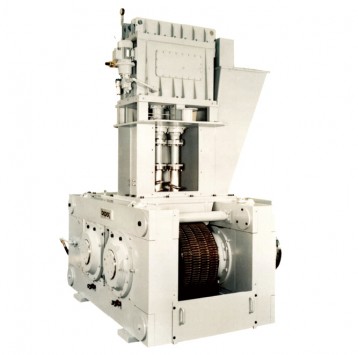
Summary
In various industrial processes a dust free material with good flowing properties is required. Briquetting and compaction technology are used to form dust free granules from powder. The most economical way for briquetting and compaction is to use a roller press. Roller presses work from very low quantities of 10 kg/h (lab size) to max. 120 t/h. Based on the materials the machines often vary in their design. In mineral processes the design is focused on wear resistance and robustness of the machine, in chemical processes the machines can be made out of stainless steel and gas or dust tight.
Principle
Briquetting and compaction are the processes for densification in a roller press. This process takes place between 2 counter rotating rolls. The powder will be fed into the machine via force-feeding (by gravity or with a screw). The rolls will take the powder. In the sliding zone there will be a difference in speed between the powder and the rolls. The nib zone starts where the pressure rises from 0 to the maximum value. A further criterion of this zone is that the speed of the material is almost the speed of the rolls. The pressure in this zone is responsible for the strength of the pressed powder. It also differs from material to material. In the deforming zone, the pressure decreases to 0 again. The characteristics of the material and its elastic behavior influence the length of this zone.
The material, which will be fed into the roller press, has the biggest influence on the result. Also the tools of the roller press like rolls, feeding system etc. can influence the process.

Fig.1 Principle
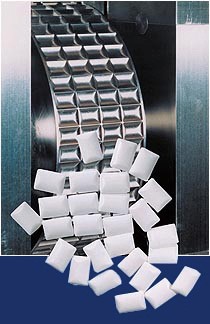
Fig.2 Briquette
Structures
A roller press consists of:
- A feeding system (screw feeding of gravity feeding) for pre-densification and dosing of the material into the rolls.
- A pressing system (2 counter rotating rolls) for densification and shaping of the briquettes or flakes.
The hydraulic system belongs to the pressing system. It contains of hydraulic piston, accumulator and hydraulic pump. The hydraulic force is the highest force, which could be created between the rolls.
Regarding the design of the pressing frame machines can be divided into machines with cantilevered shafts and middle shafts.
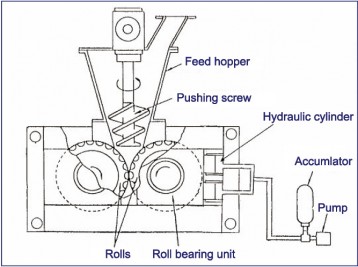
Fig.3 Structure
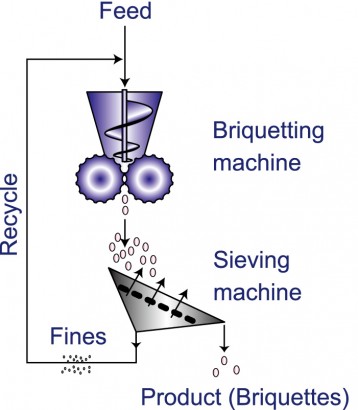
Fig.4 General Flow of briquetting
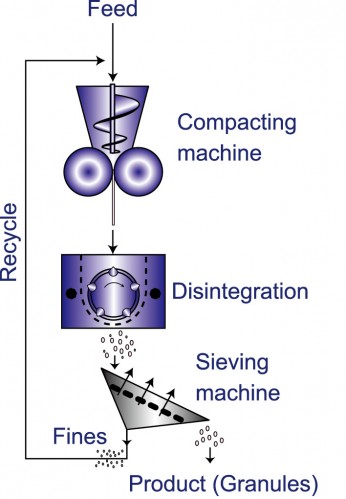
Fig.5 General Flow of compacting
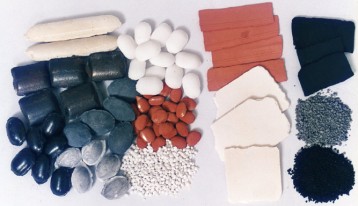
Fig.6 Briquettes and flakes
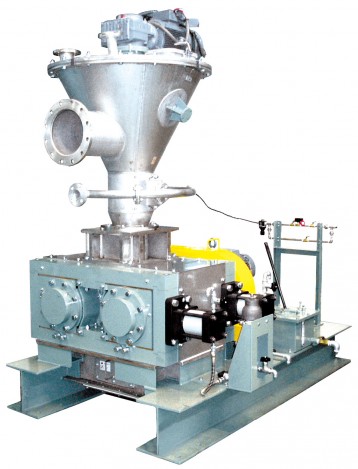
Fig.7 Compactor MSL 30
Features
Briquetting
The target of a briquetting process is always to form a single briquette. The size of the briquette depends on the size of the roller press but it normally starts at 10 mm and goes up to 120 mm. Typically after briquetting the briquettes were separated from dust and undersized material, which can be fed back into the roller press.
Compaction
The compaction process is normally used to form dust free granules to less than 10 mm. In a first process step the powder is pressed into flakes. In a second step the flakes are crushed into granules. In a third step the granules can be separated from dust and the dust can be fed back into the roller press.
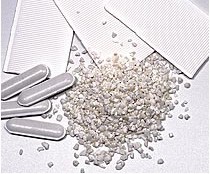
Fig.8 Briquettes and its disintegrated products

Feel free to contact us. if you have any questions or concerns.

